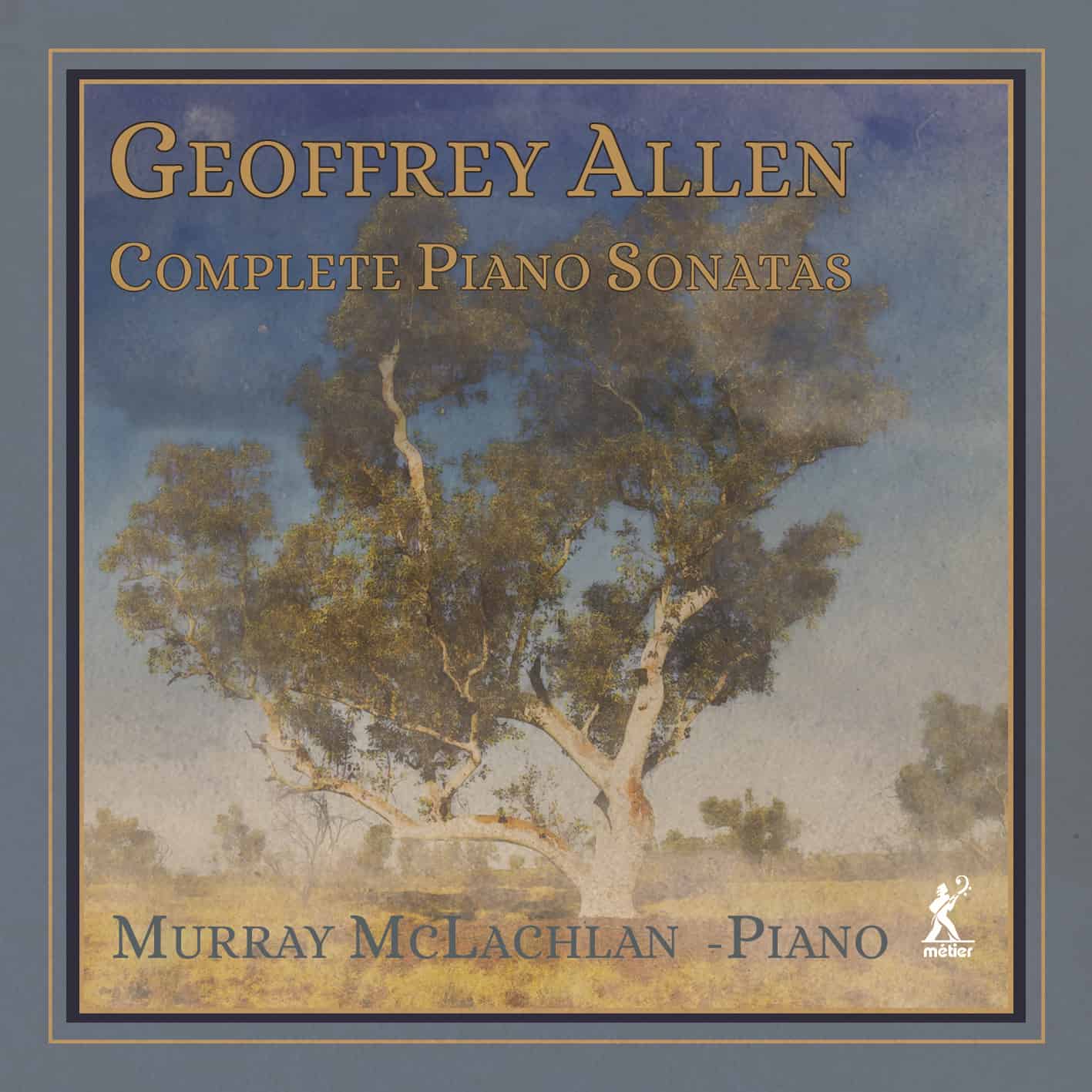British Music Society
As a tag-line at the head of his bountiful programme notes, pianist Murray McLachlan asks us a question, ‘Geoffrey Allen – The Pianist’s Havergal Brian?’ Two things could suggest that query. Like Havergal Brian, Geoffrey Allen (1927 – 2021) wrote much of his music towards the latter part of his long life. His first Sonata was begun in 1959 when Allen was 32-years-old. It was revised in 1995 when he was 68. Three of the Sonatas were completed when Allen was in his sixties, 10 in his seventies, four in his eighties. The final Sonata was composed when he was 92-years-old. Allen, like Havergal Brian, at least as a composer, was largely self-taught.
Born in Essex, Geoffrey Allen read Geography at Oxford University. After graduating, he moved to Western Australia in 1952. He worked as a University Librarian until his retirement in 1992. That was when his career as a composer really took off.
This five disc set contains what is a lifetime’s work for Allen as a composer for piano. There are in all 17 Sonatas. Most are of a similar length, averaging about 22 minutes in duration. Even with fewer movements, the overall length is mostly much the same.
At an initial listening, a line from Sir Arthur Sullivan’s song The Lost Chord came to mind. ‘My fingers wandered idly over the noisy keys’. Actually, that is not entirely fair, but why should I think of those words? The secret behind the challenging structural features of many of Allen’s Sonatas was revealed by Murray McLachlan’s words concerning the final Sonata, Number 17, Op. 97. Regarding the first movement Moderato, he mentions Allen’s ‘improvisatory spirit’. Regarding the Scherzo, the third movement, he writes, ‘taking the music in surprising directions – which only in hindsight can be seen as logical’. Of course, in preparation for the recording, Murray has studied the music in depth and has therefore gained a sympathetic understanding which does not come as easily to a first-time listener. However, some of the sonatas seem to have more of a structural backbone than others. Those sell themselves more immediately to the listener.
Piano Sonata No.2, ‘Sonata Espanola’ has four movements, each with a thoroughly Spanish title very much matched by the music itself. Salamanca is the name of a Spanish town and apparently the word has associations with magic. Melody, harmonies and rhythm certainly suggest Spanish dancing. Lagrimas de Sangre (Tears of Blood) suggests a feature of tragedy common in Spanish folk music and dance. It starts in a melancholy mood, slower but rhythmically expressive. Los Tres Encinas (The Three Oak Trees) suggests throbbing flamenco guitar music with marvellous left-hand work. The finale, Danzas Sevillanas is self-explanatory. It has the turns, stamps and twists of Spanish dance music.
Allen is a convinced pacifist. His Piano Sonata No.6, Op.39 is dedicated to the people of Kosovo and East Timor who were under torment in 1999. The final movement Presto is full of anger along with intimations of violence and war. A Sonata with a similar background of pacifist inspiration is Sonata No. 10, Op. 52 where Allen adds his voice to the Australian protest movement against the Iraq War.
Piano Sonata No. 8, Op.46 is more unusual than any other in print. The opening movement is marked Tempo di valzer. It is in waltz time as are all three other movements exploring the idea of the waltz in several contrasting tempi. It works particularly well.
Several of the faster movements stand out. The second movement of Piano Sonata No.10, Op. 52 marked Allegro giocoso delights with its playful light touch. In Piano Sonata No.11 Op.55, the movement marked Vivo come il buffone lives brilliantly up to its title.
Another very unusual Sonata is Piano Sonata No.16, Op.86. It is in one single movement but with several named sections. The composer himself names seven or eight as being important but the programme note lists nine or ten and these do stand out clearly.
Along with the 17 numbered Sonatas, there is a three-movement composition Rhapzonata, Op.51. It boasts three colourful titles fully expressed in the music. It begins with Rhapsody (over the Moon). It has filmic changes of mood which Murray refers to as ‘closely related stylistically to the cycle’. The word ‘exploratory’ comes to mind both here and in many of the other Sonatas. The second movement Canzonetta ‘In a Perfumed Garden’ opens simply. It is tantalisingly atmospheric, leading us through the garden with simple waltz music. The final movement is Toccata ‘Only on Wednesday’ (What on earth does that mean?). At least the word ‘toccata’ makes sense. This movement is referred to by Murray as ‘pianistic fireworks’. That is absolutely true.
I have not really mentioned the performances. Do I need to? Murray McLachlan is a wizard of technical piano prowess. More importantly, he reveals an amazing depth of understanding regarding music which though thoroughly attractive, poses multiple questions regarding its formal structures. Still, Geoffrey Allen could not have found a better evangelist of the piano than Murray McLachlan.
@divineartrecordingsgroup
A First Inversion Company
Registered Office:
176-178 Pontefract Road, Cudworth, Barnsley S72 8BE
+44 1226 596703
Fort Worth, TX 76110
+1.682.233.4978











![Listen to the full suite of Marcel Dupré’s Variations Sur un Noël, Op. 20 from Alexander Ffinch’s #Expectations release today! listn.fm/expectations [in bio]](https://scontent-dfw5-1.cdninstagram.com/v/t51.71878-15/588904367_2327488161082898_8709236950834211856_n.jpg?stp=dst-jpg_e35_tt6&_nc_cat=105&ccb=7-5&_nc_sid=18de74&efg=eyJlZmdfdGFnIjoiQ0xJUFMuYmVzdF9pbWFnZV91cmxnZW4uQzMifQ%3D%3D&_nc_ohc=H3rHeRayPTgQ7kNvwHCTNWE&_nc_oc=AdmdIZOqXZjxqnqb4xktsQBEe8fn8kH-rZHfdag8P438pzB6EeE0kct6QUYEh38VJT8&_nc_zt=23&_nc_ht=scontent-dfw5-1.cdninstagram.com&edm=ANo9K5cEAAAA&_nc_gid=S_Uzcgokidf1NSADQ-S_Dw&oh=00_AflqQnv7xXz7-nmUsgntKtO8D-OMZSo5AlYHwD3OqdqF_A&oe=695B1FAA)
